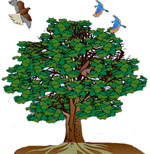Biology Related Pages:
- Biology
- Branches of Biology
- Biological classification
- Origin of Life
- Biochemical Origin of Life
- Smallest unit of Life
- Types of Cells
- Eukaryotic Cells
- Cell Cytoplasm
- Golgi body
- Mitochondria
- Function of Endoplasmic Reticulum
- Ribosome Structure
- Lysosomes
- Microtubules
- Cell Wall
- Cell Nucleus
- Cell Nucleus Structure
- Chromosomes
- Chromosome Structure
- DNA Replication
- X and Y Chromosomes
- Cell Membrane
- Cell Junctions
- Cell Division
- Amitosis
- Mitosis
- Meiosis
- Meiosis Stages
- Respiration
- Cellular Respiration
- Process of Respiration
- Digestion
- Genetics
- Gene
- Mendel’s Experiments
- Natural Selection
- The Law of Segregation
- Genetic Variation
- Crossing Over
- Gene Mapping
- Transgenic Plants
- Mutation
- Gene Mutation
- Chromosomal Mutations
- Ecological Community
- Ecosystem
- Structure of ecosystem
- Sweat Glands
- Causes of overpopulation
- Effects of overpopulation
- Population Control
- Air Pollution
What is ecosystem?
The basic functionality unit of ecology is the ecosystem, where the living and nonliving members’ exhibit close interaction. We know that, the green plants prepare the food, the animals procure their food from them and the decomposers help in recycling of those materials back to the nature. From habitat to habitat the ecosystems normally vary.
So, ecosystem is the functional unit of ecology, which deals with the inter-relationships between Delhi being and nonliving components of the environment.
What are the components of ecosystem?
There are two types of components of an ecosystem and those are (1) Abiotic component and (2) Biotic component.
(1) Abiotic components: the biotic components or the nonliving components are mainly of two types, the physical or chemical factors and chemical factors including inorganic and organic substances.
i) Physical factors: physical factors include sunlight, atmospheric pressure, temperature, humidity prevailing all the areas of the biosphere. Those are as follow:
a) Light: primarily light comes from the solar source, which acts as the only major of energy the ecosystem.
b) Temperature: temperature is another important factor for sustaining life, though the tolerance of temperature varies from organism to organism. But on an Aberdeen’s the maximum temperature is 45°C at which life is possible to survive.
c) Atmospheric pressure: the super incumbent pressure of air is 4.7 lbs. per square inch at the sea level, but it decreases with altitude and along with it, the concentration of oxygen is also deduced and this makes difficulty for breathing.
d) Humidity: the relative humidity helps in the growth of microorganisms and plants; it is also helping the growth and respiration of some animals.
ii) Chemical factors: in the study of the system chemical factors include the inorganic elements like Carbone, hydrogen, oxygen, potassium, phosphorus, sulphur, nitrogen, calcium, magnesium et cetera, which are primarily present in the soil and constitute the bio-geo chemical cycles like the Carbone cycle, the oxygen cycle and the nitrogen cycle. The organic compounds are mainly synthesized from hydrocarbons, nitrogen and other elements.
(2) Biotic Components: The living components of an ecosystem are mainly of two types, those are (a) Autotrophs and (b) Heterotrophs.
(a) Autotrophic components: At an ecosystem the autotrophic components can prepare their own food either by the process of photosynthesis or by chemosynthesis. These types of foods are primarily carbohydrate, but the other form of food, such as fat and protein are also may synthesized and they are available to the heterotrophs.
(b) Heterotrophic components: the heterotrophic components cannot prepare their own food and they depend directly or indirectly on the autotrophies. They include the primary and secondary consumers on one hand and also the decomposers or the saprophytic organisms. These saprophytic organisms cause decay of the dead plants and animals, which help in the recycling of nutrients.
Types of ecosystem: –
On the basis of region where it has developed ecosystem can be classified broadly of two types. Those are natural or macro ecosystemand artificial or micro ecosystem.
a) Natural or macro ecosystem: natural ecosystem is large insights and can be classified on the basis of total energy flow. Natural solar powered ecosystem is like forests, grasslands, lakes with an energy flow of 1000 to 10,000 kcal. Nature subsidized solar powered ecosystems like tropical rain forest, tidal estuaries with an energy flow of 10,000 to 40,000 kcal. Man subsidized solar powered ecosystems like agriculture with a mad cheap low 1000 to 40,000 kcal.
b) Artificial ecosystem: The artificial ecosystem is purely man-made and independent of solar energy. They are also called micro ecosystem and are prepared study the interrelationship between various components in laboratory conditions.
Next we go for



